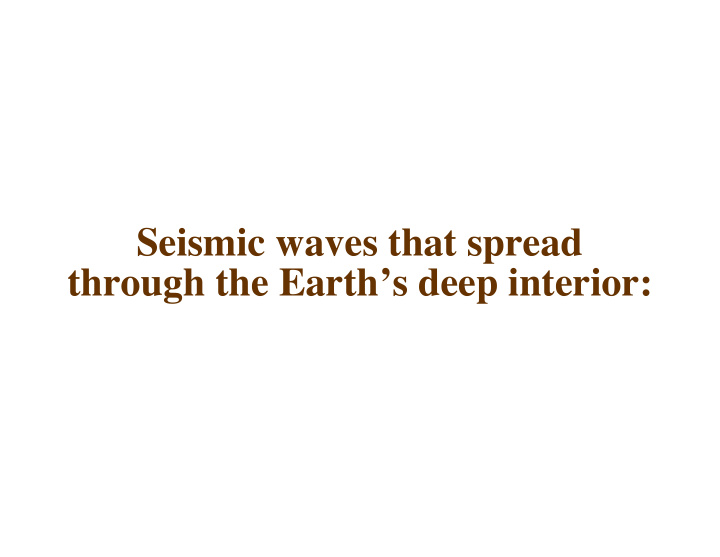



Seismic waves that spread through the Earth’s deep interior:
BANG! or QUAKE!
m t h e s o o u r r f c s e e c n a t s 90º i d t n e r e f f 60º i d t a s n o i t a t s e e 30º r h T CRUST (very thin) Seismic CORE source MANTLE
90º 60º 30º
90º 60º 30º
90º 60º 30º The wavefront position is shown after it has been traveling for several minutes. It continues to travel throughout the Earth's interior, bouncing off the core, and boun c ing off the Earth's surface.
1.5 million seismic events since 1960, located by the International Seismological Centre on the basis of data from about 17,000 stations (up to ~ 6000 in any one year)
���������������������������������������������������� ����������� �������������������������������������������������� ��������������� ������������������������������������������������������������������ �������������� ������������������� ��������������������� �������������������������������������������������������������������� ��������������������� ����������������������������������������������������������������� ���������������������������� �����������������������������
MDJ 200 km Russia 44°N 50°N HIA HIA MDJ China USK 42° BJT Chongjin 40° Japan INCN MAJO 2006Oct09 KSRS MJAR Kimchaek SSE 30° 40° 120° 130° 140°E 126° 128° 130°E
NIED seismic stations Hi-net 750 KiK-net 700 K-NET 1000 F-net 70
MDJ 200 km Russia 44°N 50°N HIA HIA MDJ China USK 42° BJT Chongjin 40° Japan INCN MAJO 2006Oct09 KSRS MJAR Kimchaek SSE 30° 40° 120° 130° 140°E 126° 128° 130°E
Station Source crust mantle Pn - wave path (travels mostly in the mantle) Station Source crust mantle Pg - paths, in the crust, all with similar travel times
Vertical Records at MDJ (Mudanjiang, NE China) from the North Korean Nuclear Test on 10/09/2006, a Nearby Earthquake Occurred on 12/16/2004 and a Known Explosion on 08/19/1998 30 60 90 120 150 180 Pn Pg Rayleigh wave Nuclear Test 373.1 km 9.7 µ /s az= 6� 2006/10/09 baz=186� M ~4.0 Lg Pn Pg Sn Earthquake 341.6 km 11 µ /s az= 23� 2004/12/16 baz=204� M 4.0 Pn Pg Sn? Lg? Explosion 289.1 km az= 14� 0.19 µ /s baz=194� 1998/08/19 M 1.9, 2 ton 30 60 90 120 150 180 time (sec)
Earthquake 01/09/92 M=3.1 D=125 km Single Explosion 09/17/88 D=149 km 3.4 km/s 5.9 km/s S P P S CRNY MDV 1-10 Hz 1-10 P to S ratio is small for an earthquake P to S ratio is large for an explosion 10-25 Hz 10-25 especially at high frequency especially at high frequency 10 20 30 40 50 60 20 30 40 50 60 70 time (sec) time (sec)
����������������������������������������������������������������������������������������������� ������������������������������������������������������������������������������������������������� �� �� �� ��� ��� ��� �� �� ������������� ��� �������� ���������������� ����� ������ �������� ���������� ������������������������ �� �� ����������� �������� ��������������� ������� ������ �������� ���������� ��������������������������� �� �� �� ��� ��� ��� ����������
1.0 0.8 0.6 Log 10 ( Pg/Lg ), 3-Component 0.4 0.2 0.0 -0.2 -0.4 Nuclear test on 25 May 2009 -0.6 Nuclear test on 9 Oct. 2006 Earthquakes -0.8 Chemical Explosions -1.0 1 3 5 7 9 11 13 15 Frequency (Hz)
from Pasyanos and Walter (2009 GRL paper)
North Korean Nuclear Test Site & Seismographic Stations in the Region 45˚N 50˚N HIA HIA Russia MDJ 500 km Russia MDJ China USRK USRK BJT 44˚N 40˚N East Sea CN2 Japan Korea Japan Sea INCN MAJO 1,5 KSRS MJAR DHAA VLA YABA 4 43˚N 10 2 120˚E 130˚E 140˚E 3 8 6 CBAI 42˚N China Chongjin THAA 9 7 2009 200 km 2013 2006 Kilju 41˚N Kimchaek North Korea East Sea Sinuiju 40˚N Youngbyun Hamhung Japan Sea km Yellow Pyongyang Wonsan 39˚N 0 100 200 300 Sea Nuclear tests Earthquakes Kaesong 38˚N Known explosions GSN stations Seoul IMS stations INCN KSRS National stations South Korea 37˚N 124˚E 125˚E 126˚E 127˚E 128˚E 129˚E 130˚E 131˚E 132˚E
3-Component Records at MDJ (Mudanjiang, China) from Three Nuclear Tests Conducted in North Korea, 12 February 2013, 02:57:51.4, 41.301˚N, 129.066˚E 40 60 80 100 120 140 160 180 Pn Pg Surface wave MDJ Vertical 371.0 km 94.2 µ m/s az= 7˚ OT=02:57:51.4 baz=187˚ 2013-02-12 MDJ N-S 70.3 µ m/s M 5.1, PDE 2013-02-12 Lg Sn MDJ E-W 59.3 µ m/s 2013-02-12 MDJ Vertical 370.8 km 37.8 µ m/s az= 7˚ OT=00:54:43.3 baz=187˚ 2009-05-25 MDJ N-S 28.4 µ m/s M 4.7, PDE 2009-05-25 MDJ E-W 23.6 µ m/s 2009-05-25 MDJ Vertical 371.5 km 9.7 µ m/s az= 6˚ OT=01:35:28.0 baz=186˚ 2006-10-09 MDJ N-S 8.2 µ m/s M 4.3 PDE 2006-10-09 MDJ E-W 6.7 µ m/s 2006-10-09 40 60 80 100 120 140 160 180 time (sec)
Vienna, 15 February 2013 A total of 96 International Monitoring System (IMS) stations have now sent data related to the unusual seismic activity detected in North Korea on 12 February 2013 to the International Data Centre (IDC) in Vienna for analysis. The magnitude of the event has been confirmed as 4.9 by the IDC. The analysed data have also enabled the error ellipse to be decreased, thus confirming the event’s location with a certainty of about +/- 8.1 km.
Recommend
More recommend